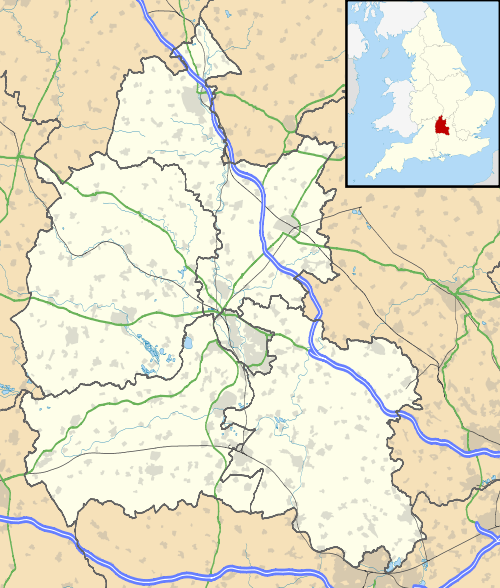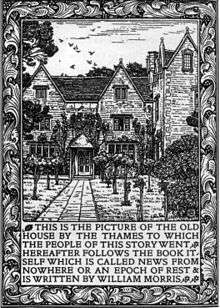Kelmscott Manor
Kelmscott Manor is a limestone manor house in the Cotswolds village of Kelmscott, in West Oxfordshire, southern England. It dates from around 1570, with a late 17th-century wing, and is listed Grade I on the National Heritage List for England.[1][2] It is situated close to the River Thames, and it is frequently flooded. The nearest town is Lechlade-On-Thames.
| Kelmscott Manor | |
|---|---|
Kelmscott Manor | |
| Type | Manor House |
| Location | Kelmscott |
| Coordinates | 51°41′20.8″N 1°38′22.1″W |
| OS grid reference | SU 25096 98888 |
| Area | West Oxfordshire |
| Built | 1570 |
| Owner | Society of Antiquaries of London |
Listed Building – Grade I | |
| Official name: Kelmscott Manor | |
| Designated | 12 September 1955 |
| Reference no. | 1199373 |
 Location of Kelmscott Manor in Oxfordshire | |


History 1570 to 1870
The house was built by local farmer Thomas Turner and remained in the family for many generations. After George Turner died in 1734, the house was rented out.[3] The house was originally called Lower House, but became Kelmscott Manor when James Turner (d.1870) purchased 53½ acres of manorial land together with the lordship in 1864. After James died the manor passed to his nephew, Charles Hobbs, who let out the property.[4]
William Morris and family
Kelmscott Manor was the country home of the writer, designer and socialist William Morris from 1871 until his death in 1896. Today it is owned by the Society of Antiquaries of London, and is open to the public on Wednesdays and Saturdays during the summer.[5]
Morris drew great inspiration from the unspoilt authenticity of the house's architecture and craftsmanship, and its organic relationship with its setting, especially its garden. The Manor is featured in Morris' work News from Nowhere. It also appears in the background of Water Willow, a portrait of his wife, Jane Morris, painted by Dante Gabriel Rossetti in 1871.
After William Morris's death in 1896, the Manor continued to be occupied by his widow, Jane Morris (who purchased it in 1913) and later, his daughters. May Morris died in 1938 and bequeathed the house to Oxford University, on the basis the contents were preserved and the public were granted access. The University were unwilling to preserve the house as 'a museum piece' and passed the house and land to the Society of Antiquaries in 1962.[4]
The internal decor today is substantially that of Morris, and includes many of his famous textile patterns as well as much of his furniture. There is a display of his textile designs in the converted loft, which would originally have been used for farm labourers. His bedroom contains many of his original books, and a collection of Dürer prints.[6] In the collection are further works by Rossetti, Sir Edward Burne-Jones, and Pieter Brueghel the Younger.
Garden
The garden includes many old trees, including a very old black mulberry at the rear of the house. The front garden is walled with a summer house in one corner, and both the wall and the summerhouse are Grade II listed.[7] The front garden contains many standard roses. Although part of the original orchard has been removed to make a small car park, many fruit trees have been left intact.
William Morris named his London residence "Kelmscott House" and the private press that he founded "the Kelmscott Press" after Kelmscott. He was buried in the village churchyard in a tomb designed by his friend and colleague Philip Webb.
See also
- Arts and Crafts movement
- Croft Manor-Lara Croft Fiction Franchise, Hatfield House, Hatfield, U.K.
- Fasnacloich, a country house in Harrisville, New Hampshire said to be based on Kelmscott Manor
References
- Historic England, "Kelmscott Manor (1199373)", National Heritage List for England, retrieved 15 December 2016
- Historic England. "Kelmscott Manor (1199373)". National Heritage List for England. Retrieved 30 June 2014.
- Britain Express Kelmscott Manor: History, travel and accommodation information (accessed 14 August 2011)
- "Online texts in progress: Broadwell parish: Kelmscott" (PDF). University of London. May 2005. Retrieved 30 June 2014.
- Kelmscott Manor website Opening Times and Admissions (accessed 16 August 2011)
- "The Pre-Raphaelites and the Northern Renaissance". Retrieved 2 September 2018.
- Historic England. "Details from listed building database (1053381)". National Heritage List for England. Retrieved 30 June 2014.
Further reading
- Crossley, Alan E.; Hassall, Tom; Salway, Peter (2007). William Morris's Kelmscott: Landscape and History. London: Windgather Press. ISBN 978-1-905119-13-4.
- MacCarthy, Fiona (1994). William Morris: A Life For Our Time. London: Faber. ISBN 978-0-571-17495-9.